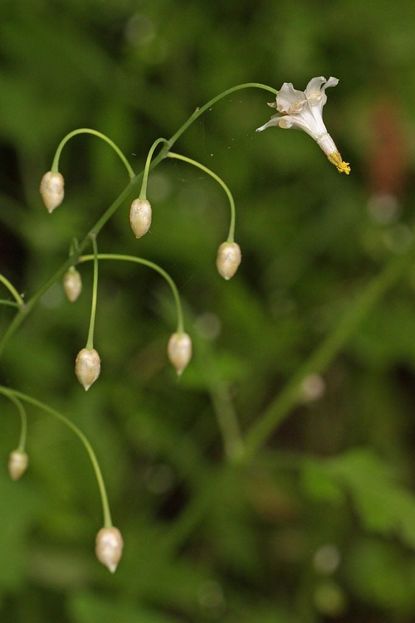Inside-Out Flower Info: Tips On Using And Growing Inside-Out Flowers


What are inside-out flowers, and why do they have that funny name? Also known as northern inside-out flower or white inside-out flower, these flowers are named because the flower petals are angled sharply backwards, which gives the blooms a windblown, inside-out appearance. Read on for more inside-out flower info, including tips for growing inside-out flowers in the garden.
Inside-Out Flower Information
Inside-out flowers (Vancouveria hexandra) are wildflowers found growing in the forest floor in cool, moist, coastal mountain ranges of Oregon and California. The plant consists of wiry stems that grow from tangled mats of creeping underground stems. The leaves look somewhat like small ivy leaves, which gives this mounding plant a soft, delicate appearance. Large clusters of miniature white flowers appear in late spring and early summer. Inside-out flowers spread slowly, eventually forming large patches.
Growing Inside Out Flowers in the Garden
Inside-out flowers are versatile plants that perform well in rock gardens, wildflower gardens, containers, borders, along paths and walkways and under trees. These woodland plants prefer cool, moist growing conditions and acidic soil, but often do well in dry shade. Afternoon shade is a must for this delicate plant. Inside-out flowers are suitable for growing in USDA plant hardiness zones 5 through 7. If you live in this climate, you will probably find bedding plants or seeds at a greenhouse or nursery that specializes in native plants. Once established, you can propagate more plants by propagating the rhizomes. Allow 12 to 18 inches (31-46 cm.) between each plant. You can also gather seeds from dry seed heads in autumn. Plant the seeds in prepared soil immediately because they don’t keep well. Don’t attempt to transplant wild inside-out flowers; remember that wildflowers are important members the ecosystem and shouldn’t be disturbed. Wildflowers are fragile and rarely transplant well, especially plants with extensive root systems.
Care of Inside-Out Flowers
Inside-out plants are disease and pest free, making care of inside-out flowers as easy as pie. Basically, just replicate the plant’s shady woodland conditions. Water as needed to keep the soil moist (but not soggy). Prune winter-damaged growth in spring to make way for healthy new growth. Divide the plants in spring if they become crowded or overgrown.
Gardening tips, videos, info and more delivered right to your inbox!
Sign up for the Gardening Know How newsletter today and receive a free download of our most popular eBook "How to Grow Delicious Tomatoes."

A Credentialed Garden Writer, Mary H. Dyer was with Gardening Know How in the very beginning, publishing articles as early as 2007.
-
 10 Best Apartment Plants To Turn Your Small Space Into An Oasis
10 Best Apartment Plants To Turn Your Small Space Into An OasisThe best apartment plants can lend an ambience of the tropics, brighten up a space, or add a touch of drama, and turn an apartment into a relaxing oasis.
By Amy Grant
-
 Grow a Bathroom Oasis: 8 Best Bathroom Plants With No Light or Low Light
Grow a Bathroom Oasis: 8 Best Bathroom Plants With No Light or Low LightSome apartment dwellers grow the best bathroom plants with no light or low light. Read how one of our favorite plant lovers does it in the big city.
By Teo Spengler